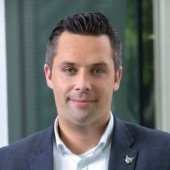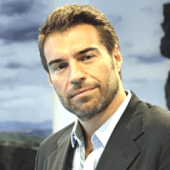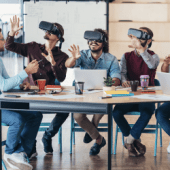Talking talent and training in 2030 and beyond with HR expert Nigel Jeremy
IN BRIEF
- 5:38 - This is an opportunity for businesses to reshape and redesign their business. They've had a lot of employee shifting going on in the last 12, 18 months. There's an opportunity therefore to relook at their business and in doing so, start rethinking perhaps how serious they are about their corporate and social responsibility strategies.
- 18:12 - The skill sets associated with big data analysis, building new technologies, I think those are going to massive. I think it's impossible to underestimate just how big that shift is going to be in the years to come.
- 21:55 - My sense is that we will see a typical role by 2030 having two to three days in the office and two to three days at home, or in fact anywhere. I'm talking for office work obviously. I think we're on that journey, and by 2030 I think it will be seen as very arcane to think you have to be in the office four or five days a week.
Joe Kornik, Editor-in-Chief of VISION by Protiviti, sits down with Nigel Jeremy, a globally recognized expert within the HR and learning and development space for the last 30 years, to talk about people and the future of work. Nigel was the former Chief Learning Officer for British Airways and before that, plenty of other firms, including Marks & Spencer, a British multinational retailer with more than 78,000 employees that was voted most admired company for attracting, developing and retaining talent. Today, Nigel's a speaker and expert on the future of work as it relates to people, talent and learning and development.
TALKING TALENT AND TRAINING IN 2030 AND BEYOND WITH HR EXPERT NIGEL JEREMY - Podcast transcript
Joe Kornik: Welcome to the VISION by Protiviti podcast. I’m Joe Kornik, director of brand publishing and editor-in-chief of VISION by Protiviti, our global content resource putting megatrends under the microscope and looking into the future to examine the strategic implications of big topics that will impact the C-suite and executive boardrooms worldwide.
Today, we’re exploring the future of work and all its implications for employees and employers as well as clients and customers over the next decade and beyond. Today, we’ve got a wonderful guest on the podcast, as I’m joined by Nigel Jeremy, a globally recognized expert within the HR and learning and development space. Previously. Nigel was the chief learning officer for British Airways and, before that, lots of others, including Marks & Spencer, a British multinational retailer with some 78,000 employees, which was voted most admired company for attracting, developing and retaining talent while Nigel was calling the shots. He’s been at this for over three decades, and I’m thrilled to welcome him to the show today. Thanks so much for joining us today. Nigel.
Nigel Jeremy: Thank you, Joe. It’s a pleasure to be here.
Kornik: Nigel, I thought we’d be past this point of starting these conversations around COVID-19 and all its various forms. But unfortunately, we do need to start there because we’re essentially now two years since the disruption, and I am curious as to your thoughts and biggest takeaways about how it has impacted talent and the workforce. Maybe some of your thoughts on how we’re doing, and how we did, with the pandemic, and then how you think those last two years will impact the next 10 when we talk about the future of work.
Jeremy: The pandemic obviously has affected every life on the planet. As of today’s date, about 382 million people have already caught COVID-19. Very sadly, six million people have passed away as a result of it. So, that this thing is still with us, and it’s likely to be with us for years to come in some shape or form, even if we learn to live with it somewhat. But there are things about COVID-19 that we have to remember in terms of the world of work. There are still some things that remain true that will not have changed, but clearly, there are some things that will have changed quite dramatically.
I’ll touch on both of those areas very briefly to set this up. Companies are still going to need to be profitable in the future. COVID-19 does not change that, and they will need to grow — they’ll need to evolve and develop their people to be successful. They’ll also need to attract and retain talented employees, but clear direction is no doubt going to continue to be needed from the top too, and leaders will need to engage and inspire their people just like they’ve always done. Employees need to be trained, and we will need to be able to spot talent. And significantly, we still do have a multigenerational workforce in the workplace, and we will need to consider those people for their engagement needs as well.
A lot already remains true when we look at business. But what’s perhaps happened is that the context has changed. The world population, for the first time, has experienced what I would cast as home isolation. We’ve experienced fear as a global community, in terms of our mortality, fear in terms of traveling to work and commuting, whether that’s international or more local, and fear of social contact too. These are things that are shifting the way we’re thinking about our daily lives as well as work in and of itself. The working-from-home routine has come up in any Western society, with any office-based working, a significant amount of home working has now started to happen, and that’s, of course, been coupled by the mass adoption of videoconferencing technology too.
We’ve got some things that are shifting the nature of work that we’re seeing right now as well. But from a psychological perspective, we’re also seeing two things going on: one, frustration, sadness and perhaps boredom with individuals who have been isolating for a little too long and miss the social contact with colleagues and friends and family.
Also, what’s become apparent is that people have been using this increased time at home with slightly less commuting time to take time out to reflect on their lives and their desires and their aspirations and asking themselves in the millions, “Is this actually what I want to do anymore? Should I just do things differently, because the old ways weren’t really working for me?” We’re now seeing that manifesting itself in what’s called the Big Resignation. We’re seeing, particularly in the U.S and the U.K., hundreds of thousands over here, millions in the U.S. looking at either changing career paths dramatically or opting out of work altogether and retiring early, and that’s going to create a big set of pressures for us in terms of our recruitment activity as we move forward.
Undoubtedly, this is a global challenge unprecedented in nature — a huge leadership challenge. We’ve done incredibly well as a global society in terms of dealing with it. I don’t think it’s over yet, but we’re certainly at, hopefully, the beginning of the end or the beginning of the return to some sort of normalization. But what this does, Joe, when you put all of that into context, it gives us some hints and tips in terms of a way forward for business — some of the things that we should be prioritizing right now.
I’ve got three for you, and then I’m sure we’ll get on to the next question. First, I would be talking about organization strategy. This is an opportunity for businesses to reshape and redesign their business. They’ve had a lot of employee shifting going on in the last 12, 18 months. There’s an opportunity, therefore, to relook at their business and, in doing so, start rethinking how serious they are about their corporate- and social-responsibility strategies, because we will come on to generations shortly, about how important some of those things are to some of the younger generations.
But if the pandemic has shown us anything, it’s that businesses that have been seen to do the right thing and support global communities are the ones that will end up winning in terms of brand at the moment. And the companies that haven’t been seen to do that may take a long time to get back to the sort of brand recognition and affiliation that they perhaps previously enjoyed. There’s a piece there on strategy — also, about property portfolio use and real estate use. But again, I’m sure we can cover that in a bit later.
The second piece is the home-working and working-hour activities that businesses now need to start looking at. We have now got to a point where it is seen to be totally acceptable to work from home and, we’ve proven, as a global working society, that it can be done — it can be just as productive — and any barriers to that continuing have to a great extent been removed. But what we also have to consider is that although that might be convenient in terms of efficiency — perhaps not to have to commute so much — we also have to consider that we are by nature social beings, and we do need to be interacting with each other on a physical basis to at least some extent.
We also have to think about how our organization, culture and brand can be maintained if people are spending a little less time in the office than they previously were. We need to be talking about things like reward strategies, because what has definitely come out of the pandemic is that job security and financial security have been affected. Therefore, people are going to want a lot more of that if it can be facilitated by organizations.
But again, for the first time — certainly, in my lifetime — the term “health security” is now being talked about in terms of ensuring that people are in a position that they can feel secure with their health, whether that’s mental or physical. And of course, to finish all of that off, we’re going to need some training and development strategy to talk to our employee workforce in terms of how they adopt new ways of working — things like meeting protocols and meeting etiquette, to name just one obvious example. There’s a lot going on in the whole pandemic, but there’s a lot to be getting after. It’s a very exciting, if not challenging, time for us as leaders.
Kornik: Yes, and certainly, you’ve put a lot on the table there for us to discuss, Nigel, as we go through this, and we certainly will get to a lot of those. I want to start with something you touched on a few minutes ago, and that’s this idea of the multiple generations in the workforce — four, five, even six generations working side by side. I’ve heard you talk about this before, and it’s a fascinating take.
Jeremy: Where this really stems from is that social studies over the last 200 years will show that teenagers, typically, but youngsters under the age of 20 in every major generation, have typically rebelled in some way, and that rebellion might have been something as simple as hair or fashion or food or alcohol. There has been something that is as mark the zeitgeist of that particular age. And, of course, as people grow up, they normalize into society — they’ll go through whatever social processes that we have: They may get partners, they may get families and they may get jobs, and all of that sort of thing will tend to go on, and they will normalize.
But what happens is, from that rebellious piece that happened in those teenagers, driven predominantly by major world or national events that were going on during their childhood and into their teens, those values and belief systems remain, and they’re not maybe at front of mind, and they’re not positioned in front of everybody in terms of a piece of fashion, for example. But the value that was developed as a result of that is sitting there.
That means that in the way that individuals look at life and the way that individuals look at the workplace, that can differ quite dramatically between these generations. And that’s what this is all about. For the first time, because we’re getting older as a society — we’re living longer and we’re retiring later as a society — we now have hit the position that we do have five different generations, five rebellions in the workplace. And it’s very interesting to see the differences between those because as leaders, we therefore have to consider these different generations in what they want in order to truly engage them as employees.
Very briefly, there are five generations right now: We’ve got the traditionalists that are over 75. They only make up about 2% of the working population globally right now. They’re important, and they were incredibly important, but with 2% of the population, we tend not to concern ourselves too much, frankly, with their needs because it’s such a small percentage of the population.
Then, you get into the big groups after that: baby boomers, 60–75 years old, 10% of the population. Generation X, my generation, 39–60, the majority of which are the leaders in their business — most leaders worldwide will fall into that age bracket. They’re 25% of the population. Then you’ve got the millennial generation, 26–38, the biggest working population we have worldwide — 45% millennials, or Generation Y make up the employment pool at the moment. Finally, the Generation Z’s, our new kids on the block up to 25, they are making up already 20% of the working population.
Now, this is not a test. I just wanted to give you a sense of that percentage level. But what this means is — and this has all shifted in the last three or four years — that Generation Y and Z now make up 65% of the global working population. They are in the ascendancy, and they have some very different needs to us Generation Xers and our baby boomer parents, and that’s where this is now becoming very interesting. Technology — baby boomers grew up in the world of paper, emails, everything in triplicate, and of course they’ve adopted new ways of working and some level of technology, but they have adopted it, as have we Generation Xers.
Millennials however, grew up with tablets and iPads and any other form of technology we would class as state of the art today, and they are digital natives, and they, as well as Generation Z’s, are into everything being online, everything being available, everyone being unique. And if you need something, you can get it by tomorrow, and that it creates a whole new paradigm for the way you look at life and work. And the tech natives are truly the Generation Z group. These are the people that are now performing their lives. If it’s not online, it’s not real.
They need constant connection. They absolutely want freedom, flexibility and choice just like the millennials. But they also want time with their manager. They want to feel unique and different and that things are tailored towards them, because online, that’s how they’ve grown up. And the one big shift, and the last big shift, I mention now between the boomers and the Generation Xers together — this is the Y’s and the Z’s — is the embracing of diversity and uniqueness. We’re seeing a sea change.
We only have to look at any news these days to see that social consciousness — doing the right thing, is at the forefront of these generations’ minds, not something that we do alongside, perhaps — as it might have been with us as Generation X, and that that gives rise to different types of issues in the workplace. A big question for any board group will be, how do we innovate? Do we involve the Y’s and the Z’s — particularly the Z’s a bit more — and does our attraction narrative for employees need to be green and socially responsible because they just won’t join unless we’re seen to be a force for good as a corporate entity?
Kornik: Right. That sense of purpose certainly permeates everything. I want to talk about that new generational reality you just laid out for us. It obviously has a lot of impacts around talent models and talent strategy. And you got into this, but if you could put a bow on it for me as it relates to, say, training and development, leadership development, high-potential employees, some of those traditional HR things that you certainly had a lot of success with as chief learning officer at British Airways, where you were responsible for 40,000-plus employees. You’ve certainly had your experience in this. I’d be curious to hear your thoughts about how this new reality, this generational reality, turns those talent models and strategies on their head.
Jeremy: For me, the good news is that the talent strategy, in terms of the structural approach to talent identification and development, I don’t believe needs to change. Most strong organizations on the talent front create a language of behavior and look to develop everyone around that in terms of the competency frameworks that they’ve got, and that’s a portfolio of learning for everyone. But then they surround that with a strong performance-management system which identifies who the top-performing employees are. They then match that up to a very clear set of criteria around talent identification in terms of who has the high potential to succeed further in the organization.
When they connect those two — past performance plus future potential — they’re then able to tailor individualized development programs for those high-potential individuals. If they get that right, we’re back to recruitment again, because these kids and older people are going to get promoted if you’ve done everything right.
Now, that process, broadly speaking, will stick. And it’s got its own challenges, but it is a process that will work if you if you’re strong enough to keep deploying strategy of all of those four, five areas that I’ve just talked about. The thing that will shift — that needs to shift — is that first thing that I talked about, that central language.
When we talk about the competencies of today and the high-potential indicators — the specific competencies that draw out the individuals that might lead in the future versus the individuals that are going to be great employees but may not have that leadership potential — when we look at the language, you could pretty much go to most organizations, certainly, in the last 20 years, and they all have a fairly similar competency framework. It would be very rooted in ’80s and ’90s and early-2000s business-speak. However, what we now are in a place of looking at, when we see the new generations coming through and what that will mean for organizations, is that that core language needs to shift quite dramatically.
Kornik: Let’s talk about skills and capabilities that will be shifting, because clearly, not only generationally, the world is evolving, and we’re going to obviously end up at a very different place. When you look out to 2030 and beyond, what skill sets and capabilities do you think will be in the highest demand?
Jeremy: For me, there are five or six major skill sets that we have to be thinking about, and we probably need to start investing in those things now for them to be available and at our disposal by 2030. I’ve touched on a couple already — critical thinking and problem-solving. We’re going to have a lot of intractable issues in the future that we are going to have to try and make some very big judgment calls on not just as leaders, but as individual day-to-day operational activity — creativity, innovation, the ability to self-manage.
If we see technology going the way it is in terms of interaction in the workplace, the ability to self-manage would become a big competence for us. The whale in all of this is quite clearly technology use and technology development. The skill sets associated with big data analysis, building new technologies, those are massive, and I don’t pretend to know anywhere near as much as I should about that particular competence, but it’s impossible to underestimate how big that shift is going to be in the years to come.
The big one I would connect particularly with what we’ve talked about earlier in this discussion would be leadership and social influence and social intelligence. I touched on leadership earlier in terms of that the way we now undertake, and the way we will need to undertake, our leadership activity in the future may need to change. We still need to be good leaders, but how we do it will be somewhat different. The social influence and the social intelligence, this is more about how we get the capabilities within our organization that are going to speak and resonate with the public, our customers — that it’s not just our employees that we need to believe in what we do.
I believe it already is starting — a worldwide movement of, we will only want to deal with people who are doing the right thing. We will only want to spend money with people who are doing the right thing. From an economic perspective and a business perspective, we need that skill. But also, it’s a pretty damn good thing for society in general that we start developing those types of skills and intelligence within our workforce right now. The social intelligence stuff is for everybody. It’s all about diversity, inclusion, the ecology and environment — how we interact with each other and with the planet and with other businesses and with our customers — that helps our organizations be seen and be a force for good. Technology is the whale, but this whole social influence and social intelligence would be the big leap alongside that.
It’s an interesting time to watch this unfolding, because the role-purpose values, the satisfaction engagement, all of those issues, they have been high on the agenda in most organizations, I’d argue — certainly, most I’ve seen — and they will remain high on the agenda in the future. The difference now is that Generation Y and Z’s employees — and don’t forget, within 10 years, they will be leaders of organizations as well — they will demand that purpose, values, engagement are real and meaningful in their organizations.
If organizations in the interim, while we make that journey, don’t deliver on this, we already know that 65% of the workforce are either Y’s and Z’s, are in a place which is, “If you won’t do it, I’ll go and work for somebody that does.” We’re really at a tipping point here in terms of which generation has got the power at the moment. I feel as if I’m handing the X rings over to the millennials literally and figuratively as we speak.
Kornik: What’s the future of the corporate office as we know it today? And look in 2030 and tell me your view of that of that office space.
Jeremy: Certainly, in the initial stages of the pandemic — in that first year, where many people were genuinely stuck at home for months and working from home — there was a thought that perhaps this was a complete sea change, and this was going to be the complete way of working for the future. I don’t subscribe to that. Even today, it’s starting to pan out that there is some level of return to the office. But it is a shift. We are on the journey on this.
My sense is that we will see a typical role by 2030 having — I’m talking for office work, obviously, Joe — typically, two to three days in the office and two to three days at home or, in fact, anywhere. We talk about home working right now. I think it’s going to not necessarily be home working. It could be you’re sitting on the beach in Miami. As long as you’re working, who cares? We’re on that journey, and by 2030, it will be seen as it would be very arcane to think you have to be in the office four or five days a week. That’s coming. Part of it’s here. It depends on the forward-thinking nature of different business leaders in terms of how much that’s happening — clearly, true, open-plan hot desking, these are not new ideas, but I think that it will be endemic in itself. Everywhere you will go, you will see this.
Also, we can expect house builders and landlords, the rental market, to respond. We may see that whereas perhaps somebody right now would get extra floor space in a new house for a bathroom, we might see a lot more new housing going up which has got extra studies or office space within, because there’s definitely a shift going on with that. The builders will go with the marketers where the demand is. We will see that, and landlords trying to convert their properties to be more available for home working too.
Clearly, videoconferencing is already here, but we’ll see, again, technology on this develop in the coming years to an extent that it becomes as simple as a phone call — literally, a press of one button, and you’re with your friends, and you might have six or eight people. I’m interested to see if we can develop — and we will develop — technology that creates a virtual room, a virtual desk around you. I’m not talking on-screen here. I’m talking about chairs around you with faces in there that sometimes you see in movies. That will be coming to a point near us without too much delay.
As we’ve said, business and opportunity to reduce the real estate costs, but which also delivers environmental benefits. Of course, let’s not forget that. There’s a win-win if you think about that social consciousness that we’re talking about here as well. It’s more of the same but a bit more developed. By the time we get to 2035, though, Joe, there’s a real question of whether there will need to be corporate offices. And if there are places of social interaction, work interaction, then it’s certainly growing in the U.K. and the U.S., this ability to rent an office for a day — these types of businesses where you can rent a boardroom and eight of you turn up, and then you do your business for that day, and then you’ll see each other again in two weeks’ time for the one day. But it’s just one-fee-type approach. We will see that, at least, as a market that’s trying to break through amongst, clearly, a number of other things.
Kornik: What about these companies that have built a lot of their success on culture in terms of employees and in terms of having a culture where they bring people together and there’s a lot of interaction and collaboration? Can we do that without a corporate office or an office space? We’ve been doing it for two years, but can we continue to do it? Is it sustainable?
Jeremy: We’re going to have to think differently if we are going to do it. Fundamentally, as I said very earlier on in this cast that, we have to remember that humans are social beings. We need physical interaction. It’s great to have an audio, it’s great to have a moving picture on the screen, but we should never pretend that anything can truly replace looking somebody directly in the eye and feeling their presence in the room opposite you, and therefore creative and innovative ways of making that happen. This is where I came into rental offices, where we don’t necessarily have to be together to create culture, to create brand. You don’t have to be together five days a week. You might need to be together 20 days a year. If those 20 days are beautiful days ingrained in brand-customer relationships, that would be the fuel that we can use when we’re using other media afterwards to sustain us.
Kornik: When you look out, you mentioned 2035, and that’s a nice, round number we can look at, and you’ve made many predictions here. But I’m wondering if you have a bold prediction in your mind about where we’ll be from a work perspective. What will be the most striking difference between 2035 and today? Ultimately, what I would love to know is, will employees be more engaged, more productive, more satisfied — essentially, more fulfilled with their working lives, let’s say — in 2035 than they are today?
Jeremy: I’ll answer your last question first, Joe, if I may. They will, is the genuine answer, and it will be incumbent upon us as Generation X leaders to try and make that shift happen. But that shift will truly embed when we get Generation Y and Z’s leaders into the boardrooms. We can’t rush that. They have to develop their own careers to a point where it’s right for them to join the boardrooms. But when they do, and when they become the large minority or the majority in that boardroom, we’ll see things change very quickly.
By 2035, doing the math, we should be in that in that space by then. We will see corporate responsibility as a business imperative, and that would be driven, as I said, by those Y and Z’s leaders. We’ll see leaps of innovation in technology. We will be solving global societal problems, whether it’s energy, climate issues, hunger, disease. We’ve shown in the last two years what we can do in terms of vaccine programs. It shows that when the world puts its mind to something, things can happen. It’s having enough of a burning platform for us to make these types of things happen.
Kornik: What a far-reaching and deep dive into the future of work that you’ve taken us on here today. I appreciate that. Thank you, Nigel, for your time today.
Jeremy: Thank you, Joe. It’s really a pleasure. Thank you.
Kornik: Thank you for listening to the VISION by Protiviti podcast. Please rate and subscribe wherever you listen to podcasts. Be sure to visit us at Vision.Protiviti.com. For Nigel Jeremy, I’m Joe Kornik. Until next time, thank you.
Experiencing a stellar HR career across some of the world’s biggest brands and latterly the Chief Learning Officer for British Airways, Nigel Jeremy is a globally recognised expert within the HR and Learning and Development profession. Nigel is a successful business author with a strong international reputation as a conference speaker in his fields of expertise. His speaking topics span all aspects of HR, with a particular focus on leadership, management and executive development, and the creation of employee-centric culture.
Did you enjoy this content? For more like this, subscribe to the VISION by Protiviti newsletter.






























